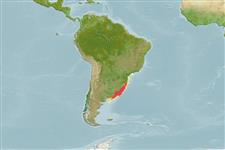Environment: milieu / climate zone / depth range / distribution range
Ecologie
marien demersaal; diepte 10 - 190 m (Ref. 26268), usually 10 - 60 m (Ref. 26268). Temperate; 20°S - 45°S, 63°W - 39°W (Ref. 26268)
Southwest Atlantic: southeastern Brazil to about El Rincon, central Argentina.
Grootte / Gewicht / Leeftijd
Maturity: Lm ? range ? - ? cm
Max length : 31.9 cm SL mannelijk / geslacht onbekend; (Ref. 26268)
Dorsale stekels (totaal): 0; Dorsale zachte stralen (totaal): 108-114; Anale stekels 0; Anale zachte stralen: 92 - 97. No lateral line on ocular side. Light brownish on ocular side, with 9 to 10 indistinct dark bands; posterior parts of dorsal and fin membranes blackish; no black blotch on dorsal and anal fins and opercle (Ref. 27363).
Occurs in coastal areas (Ref. 36453). Mainly feeds on polychaetes; also on other benthic preys such as gammaridean amphipods, cumaceans, and mysids. A "smell and touch" kind of predator, little is known regarding its ecology (Ref. 26268).
Levenscyclus en paargedrag
Maturiteit | Voortplanting | Paaien | Eieren | Fecunditeit | Larven
Munroe, T.A., 1998. Systematics and ecology of tonguefishes of the genus Symphurus (Cynoglossidae: Pleuronectiformes) from the western Atlantic Ocean. Fish. Bull. 96(1):1-182. (Ref. 26268)
Status op de Rode Lijst van het IUCN (Ref. 130435)
Gevaar voor de mens
Harmless
Gebruik door de mens
Meer informatie
Lokale namenSynoniemenMetabolismePredatorenEcotoxicologieVoortplantingMaturiteitPaaienPaaiaggregatiesFecunditeitEierenOntwikkeling van de eieren
ReferentiesAquacultuurAquacultuurprofielKweeklijnenGeneticaElectrophoresesErfelijkheidZiektesVerwerkingNutrientsMassaconversie
Tools
Speciale rapporten
Download XML
Internetbronnen
Estimates based on models
Preferred temperature (Ref.
123201): 11.3 - 21.1, mean 15.6 °C (based on 224 cells).
Fylogenetische diversiteitsindex (Ref.
82804): PD
50 = 0.5000 [Uniqueness, from 0.5 = low to 2.0 = high].
Bayesian length-weight: a=0.00363 (0.00220 - 0.00599), b=3.24 (3.09 - 3.39), in cm total length, based on LWR estimates for this species & Genus-body shape (Ref.
93245).
Trofisch niveau (Ref.
69278): 3.3 ±0.43 se; based on food items.
Weerstandsvermogen (Ref.
120179): Gemiddeld, minimale populatieverdubbelingstijd 1,4-4,4 jaar (Preliminary K or Fecundity.).
Fishing Vulnerability (Ref.
59153): Low to moderate vulnerability (29 of 100).
